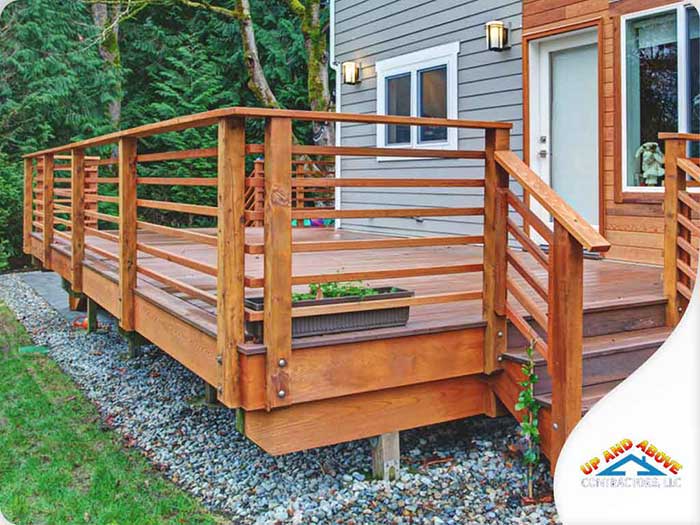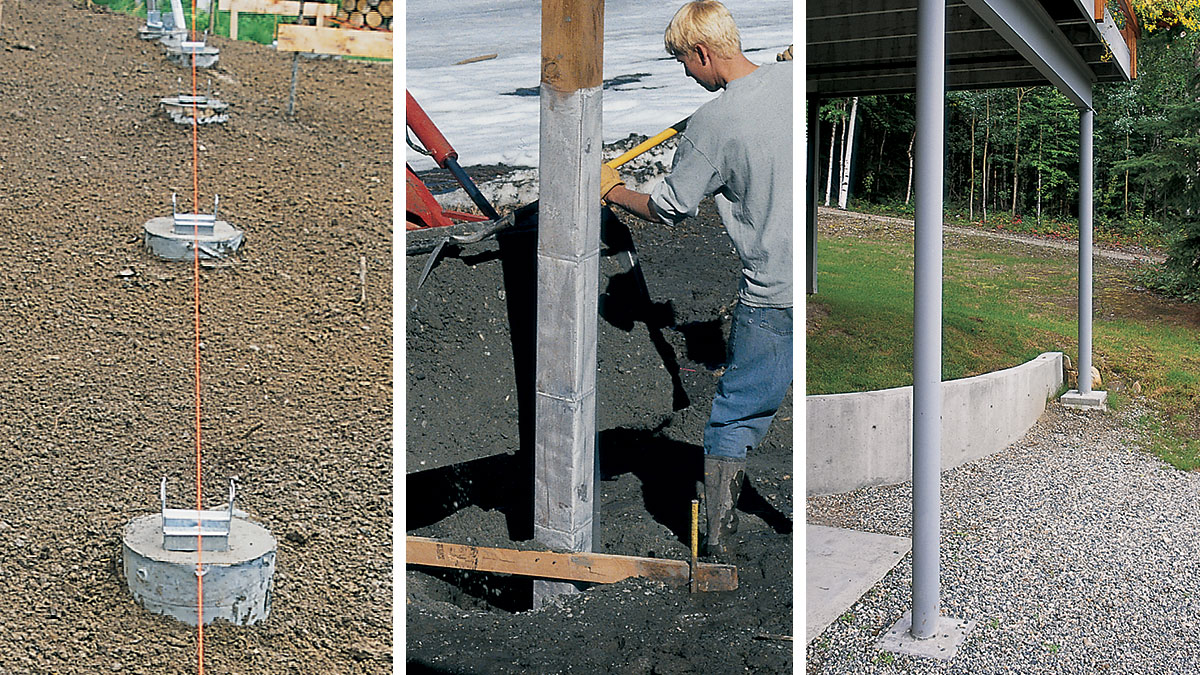Make Sure Stability and Durability With Correctly Installed Deck Grounds
Deck footings might not be the most extravagant aspect of deck construction, but they play a vital duty in making sure security and long life. In this discussion, we will certainly explore the significance of appropriate deck footings, variables to take into consideration during installment, different kinds of grounds available, step-by-step setup overview, and maintenance tips for making certain resilient grounds.

Relevance of Appropriate Deck Footings
Why are properly mounted deck footings essential for the security and longevity of your deck? The response hinges on the essential duty that deck footings play in supporting the weight of the whole structure. Deck grounds are the foundation on which the deck rests, transferring the tons from the deck to the ground. When footings are not correctly set up, it can bring about a variety of concerns that compromise the stability and durability of the deck.
Firstly, properly set up deck grounds distribute the weight of the deck evenly, stopping any type of irregular settling or sinking. This is particularly important in areas with unpredictable dirt, as it aids to reduce the risk of the deck shifting or breaking down. In addition, well-installed footings make certain that the deck remains degree, stopping any kind of structural damage that can occur when a deck becomes unequal.
Second of all, effectively mounted footings give a strong anchor for the deck, protecting against excessive movement and persuade. This helps to keep the structural honesty of the deck, decreasing the risk of mishaps or injuries. It likewise minimizes the deterioration on the deck, enabling it to endure the aspects and normal use for a longer duration of time.
Aspects to Consider for Deck Footing Setup
When mounting deck grounds, there are numerous crucial factors to consider for proper setup. These variables can considerably affect the security and durability of your deck. You need to identify the type of soil on which the deck will be built. Various soil kinds have various load-bearing capacities, so it is vital to conduct a dirt test to make sure the grounds can support the weight of the deck and its residents. Furthermore, the place and design of the deck need to be meticulously planned to prevent any challenges such as trees, energy lines, or below ground pipes. It is additionally essential to consider the neighborhood climate and climate conditions, as these can influence the sturdiness of the grounds. For instance, regions with a high water table may need extra actions to stop water damage. The dimension and material of the grounds ought to be selected based on the size and weight of the deck, as well as the regional building codes and guidelines. By thinking about these factors, you can make certain the correct installment of deck footings and enjoy a stable and long-lasting deck.
Sorts Of Deck Grounds to Pick From
There are a number of various types of deck footings offered for you to pick from. Each kind has its very own advantages and downsides, so it's vital to consider your details demands and the conditions of your deck prior to choosing.
One typical sort of deck ground is the concrete footing. This involves excavating holes in the ground and pouring concrete into them to develop a strong structure. Concrete grounds are sturdy and supply outstanding stability, making them appropriate for decks in locations with difficult dirt problems or high wind lots.
An additional option is the helical pier footing, which includes a steel shaft with helical plates that are screwed right into the ground. These footings fast to set up and can be used in various soil kinds, including sandy or clay soils. They are also flexible, permitting for easy progressing of the deck.
Sonotube footings are one more popular choice. These grounds are developed by positioning a cardboard tube in a hole and loading it with concrete. Sonotube grounds are relatively easy to set up and offer sufficient stability for smaller sized decks or in areas with less demanding dirt conditions.

When choosing the kind of deck footing, it's critical to think about factors such as soil problems, deck size and weight, neighborhood building content regulations, and personal choices. By choosing the ideal footing type, you can ensure the stability and longevity of your deck.
Step-by-Step Guide for Setting Up Deck Footings
Identify the place: Start by noting the specific placement of each footing utilizing stakes and string (Deck Footings). Take into account any type of regional building ordinance or guidelines pertaining to obstacle ranges
Dig my link the holes: Use a message opening miner or an auger to dig the openings for the grounds. The deepness will certainly rely on the frost line in your area and the kind of dirt. Typically, a depth of at the very least 36 inches is advised for stability.
Level the openings: Ensure that all-time lows of the holes are level (Deck Footings). This can be accomplished by utilizing a degree or a straight board throughout the top of the openings
Include crushed rock: Place a layer of gravel at the bottom of each opening to boost water drainage and avoid the ground from penetrating the dirt gradually.
Put the footing forms: Put the ground forms right into the openings, ensuring they are focused and level. Usage risks to protect them in place.
Mix and put concrete: Follow the directions on the concrete mix bag to prepare the concrete. Pour the concrete right into the footing kinds, filling them entirely.
Smooth the surface: Make use of a trowel to smooth the surface of the concrete and get rid of any air pockets. Permit the concrete special info to cure according to the producer's directions.
Upkeep Tips for Lasting Deck Grounds
Proper upkeep is essential for guaranteeing the long life and security of deck grounds. By regularly checking and maintaining your deck grounds, you can protect against damages and prospective safety risks. One essential facet of upkeep is to frequently inspect for any kind of indications of wear and tear, such as cracks or movement in the footings. If you see any type of problems, it is necessary to resolve them without delay to prevent more damage.
Regular cleaning is additionally important for preserving deck footings. Debris, dirt, and greenery can build up around the footings, which can result in moisture build-up and decay. Cleaning the footings regularly, making use of a stress or a brush washing machine, can assist protect against these concerns and extend the life expectancy of your deck.
In addition to cleaning, it is essential to keep the area around the footings clear of any type of blockages. Prevent piling things versus the grounds or enabling plants to expand as well close to them. These blockages can trap wetness and create the grounds to weaken over time.
Lastly, routine resealing of the grounds is advised to shield them from moisture and various other environmental factors. Applying a water resistant sealer can aid prevent water damages and prolong the lifespan of the grounds.
Verdict
To conclude, correct installment of deck grounds is important for making sure stability and durability of your deck. Elements such as dirt kind, tons ability, and local building codes need to be thought about when selecting the best type of deck footings. Complying with a step-by-step guide for installment and regular upkeep will certainly help to guarantee the footings stay lasting and resilient.
In this discussion, we will certainly check out the value of proper deck grounds, factors to think about during installment, different types of footings offered, step-by-step installation overview, and maintenance suggestions for making sure durable grounds. Deck grounds are the structure on which the deck relaxes, transferring the tons from the deck to the ground.One usual type of deck footing is the concrete ground. Put the footing types: Put the footing creates right into the openings, ensuring they are centered and degree.In conclusion, proper setup of deck grounds is critical for making sure security and long life of your deck.